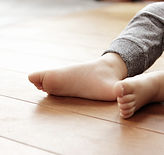
Corns
Corns:
Corns are calluses that form on the toes because the bones push up against the shoe and put pressure on the skin. The surface layer of the skin thickens and builds up, irritating the tissues underneath. Hard corns are usually located on the top of the toe or on the side of the small toe. Soft corns resemble open sores and develop between the toes as they rub against each other.
Corns and calluses are protective layers of compacted, dead skin cells. They are caused by repeated friction from skin rubbing against bony areas or against an irregularity in a shoe. Corns ordinarily form on the toes and calluses on the soles of the feet. The friction and pressure can burn or otherwise be painful and may be relieved by moleskin or padding on the affected areas. You should never cut corns or calluses with any instrument, and never apply home remedies, except under a podiatrist's instructions. If a corn or callus is painful or you see any blood in it, you should have it treated by a podiatrist. Pain or bleeding means the corn or callus is irritating the deeper layers of skin that contain nerves and blood vessels. Treatment will involve debriding, or paring the corn or callus so as to remove it without damaging nearby healthy skin.We offer many proven ways to treat these conditions. Contact us to arrange for a comprehensive examination by one of our caring doctors.
Facts about Corns:
• They often develop on the areas near the joints of toes in response to shoe friction, especially if you have hammertoes.
• Another common place for a corn is the side of the little toe.
• Soft corns can develop in between toes in response to two toes rubbing against each other.
• Tiny "seed corns" occur most often on the ball of the foot and can be quite painful.
• They can sometimes be mistaken for warts.
Facts about Calluses
• Calluses are often larger than corns and occur in response to friction from shoes or walking barefoot.
• They often develop on the soles and ball of the foot because these areas experience the most ground pressure.
• Heel calluses may develop into painful cracked areas of skin that become wounds.
Improperly fitting shoes are a leading cause of corns. Toe deformities, such as hammertoe or claw toe, also can lead to corns. In a visit to our office, your corns can be shaved with a scalpel. Self care includes soaking your feet regularly and using a pumice stone or callus file to soften and reduce the size of the corn. Special over-the-counter non-medicated donut-shaped foam pads also can help relieve the pressure.
.png)
.png)






